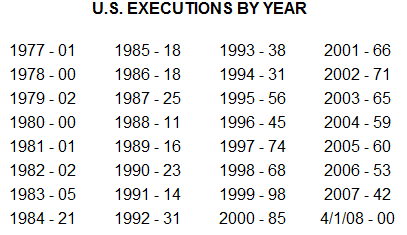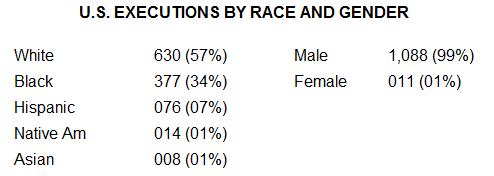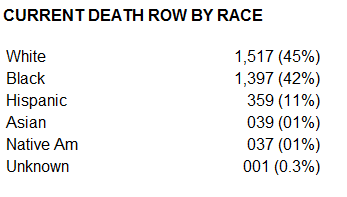Pro-Death Penalty, Reaction Paper Example
Abstract
This paper puts forward the stance that supports the argument in favour of the death penalty in the United States of America. It is essentially a scholarly review that considers the opinion of subject matter experts and those considered having professional knowledge in this area. The paper mainly examines the social issues and implications of imposition of the death penalty; it does not examine the counter arguments or those against the death penalty. The paper is structured into four distinct parts, (i) Introduction and Background to the death penalty in the USA (ii) A statement of the problem ( iii) Analysis of the problem and (iv) Conclusion. It answers the question – Is the death penalty required in the framework of US Criminal law.
Introduction and Background
In 2009 Amnesty International released its annual report on the state of the world human rights. Included in the report is that the USA has the most active death penalty practice with 100 new death sentences and 52 executions. Recently a book has been produced voices of the death penalty debate that explores the argument a for and against keeping the death penalty in the USA. “This text readers through the testimony of experts, ordinary citizens, victims, organizational leaders, religious leaders and those he exonerated and freed from death row.” (Murphy, 2010).
On the 1st April 2008 the death penalty was authorized by 37 states in the USA, the Federal Government and the US Military. It was in 2008 that the Nebraska Supreme Court sanctioned the use of the Electric Chair in violation of the Nebraska constitution. Statistics record the number of US executions, since 1976, as being 1,099 and 3,267 placed on death row. [1]
The Table in Fig 1 to the right illustrates the number of Executions in the USA by year since 1977 to 2000. The last decade has seen an alarming increase.

Figure 1: US Executions 1977-2005
Figure 2: Illustrates that the bulk of those executed are white males with only a small proportion of female victims. This somewhat debunks the myth of the bulk of those executed are of black African / American origin.

Figure 2: Executions by Race and Gender
Fig 3 shows those currently on death row by race or origin statistics with nearly half being of white origin and the remainder black people.

Figure3: Death row by race
It is interesting to note that of all those retained on death row some 65% had previous felony convictions and a record of past criminal behaviour.
Statement of the problem
The debate on the imposition of the death penalty in the USA has been really based on proper use of the sentence. The execution of the mentally ill, the ability to get the sentence wrong; there is no reprieve from the death sentence. Statistics show 63 innocent death row inmates released since 1973 as a result of incorrect picture. There is however still a large lobby group that supports the retention of the death penalty as a deterrent for homicide and violent crime. The USA has a larger juvenile delinquency problems throughout major cities, with places like New York, Chicago, Los Angeles and Detroit having higher rates of statistics. The death penalty has been imposed against juveniles, particularly the state of Texas, where there is a zero tolerance factor for homicide cases. It is considered that the juvenile problem is a major social issue and that much more attention should be driven towards rehabilitation of the offenders before they become more hardened criminals and turn towards homicide. California’s statistics illustrate the point. The court simply cannot cope with the flow through of the young offenders and various little attempt is made at social rehabilitation or reform.
An example of a case that resulted in detention in Colorado might we have received a different verdict in the State of Texas ” The tranquility of a small Colorado town was shattered on April 25, 1983, when two sisters, ages 9 and 14, were bludgeoned and stabbed to death while at home alone after school. Billy Keenan, a 13-year-old neighbour with a history of psychological problems, became the prime suspect after casually revealing that he knew the order in which the girls were murdered and after a detective found blood spattered on his jeans. In the ensuing investigation, Billy admitted to the crime while under hypnosis, and he was sentenced to two years, the maximum sentence allowed for a convict under 14.” (Adams, 1991).
The Pro-death penalty lobby group
“If we execute murderers and there is in fact no deterrent effect, we have killed a bunch of murderers. If we fail to execute murderers, and doing so would in fact have deterred other murders, we have allowed the killing of a bunch of innocent victims. I would much rather risk the former. This, to me, is not a tough call.”
John McAdams – Marquette University/Department of Political Science, on deterrence
There have been numerous arguments put forward in support of the death penalty, amongst the most compelling arguments are:
- Elimination– Capital punishment has been extremely effective in terms of removing the worst elements of criminals from our society. The merger is cannot reoffend and as such we are protecting other potential innocent victims in our society.
- Cost– it is extremely expensive to give a convicted murderer life imprisonment, and the cost becomes the burden of the taxpayer. Equally, the cost of the courts in endless appeals. Consider that in the USA, the average time spent on death row is 12 years.
- Deterrence– statistics both in the USA and overseas to support the fact that the death penalty is an activity terror and to violent or major crime. The city when the criminal is time to stop and reflect about the consequences. One of the issues here, however is where the murderer is seen to be mentally ill criminally insane.
- The UK case study– rates of murder in the UK have doubled since the abolition of the death penalty in 1964. Between 1965 in 1969 recorded statistics showed a 125% increase in murder. The US simply seen a drop in murder and statistics, where there was an increased use of the death penalty, dropping from 24,562. In 1993 to 18,209 in 1997.
The country of Singapore actively supports the death penalty and this is seen as a major deterrent in that country. ” Singapore always carries out death sentences where the appeal has been turned down, so its population knows precisely what will happen to them if they are convicted of murder or drug trafficking – is this concept deeply embedded into the sub-consciousness of most of its people, acting as an effective deterrent?
In 1995, Singapore hanged an unusually large number of 7 murderers with 4 in 1996, 3 in 1997 and only one in 1998 rising to 6 in 1999 (3 for the same murder” (Bureau of Justice Statistics, 2010).
Amnesty International did not purely point the finger at the USA in terms of the human rights issues of the death penalty. They equally looked at other countries that adopted the same philosophy ” Only China, Iran and Vietnam held more executions in 2004 than the US, according to rights group Amnesty International. Texas, Virginia and Oklahoma account for more than half of the 1,000 executions performed since 1977. Texas alone has carried out 355. ” (Westhead, 2005).
Although in general terms the USA is seen as slowly moving away from the death penalty, nevertheless this is not seen as a view entirely adopted by Congress. The concept of the mentally ill committing murder does not entirely receive a great deal of support from a number of congressman. In fact there has been blame placed on the inadequacy of the system to prosecute the death penalty in more efficient and expedient means. ” Three years ago, the court declared it unconstitutional to execute criminals who were mentally retarded. But some Republicans in Congress are concerned that all the legal wrangling is delaying justice. They are now trying to pass legislation to speed up executions and reduce the time between conviction and execution, which usually exceeds 10 years” (Westhead, 2005). The Republican members in Congress are also taking a close examination on extending the range of the death penalty considering first degree murder and acts of terrorism. ” Separate measures are under way to increase the range of crimes punishable by death. One proposal would extend the death penalty currently reserved for first-degree murder to offences such as conspiracy to commit terrorist acts and certain gang-related crimes.” (Westhead, 2005).
Not every one agrees that the Death Penalty is an effective deterrance and Decker produced an interesting piece of research in the Criminal Justice Journal ” The deterrence measure (executions) made no contribution to the variation in homicide rates. Thus, the authors conclude that there is no deterrent effect for the death penalty on homicides in Illinois.” (Decker & Kohfeld, 1984).
A Gallup poll illustrates that still some 65% of Americans continue to support the use of a death penalty in the USA. Americans continue to support the fact that the death penalty remains an adequate line of defence and detterant against the more radical emements that would seek to harm society ” However, for many Americans, agreement with the assertion that innocent people have been put to death does not preclude simultaneous endorsement of the death penalty. A third of all Americans, 34%, believe an innocent person has been executed and at the same time support the death penalty. This is higher than the 23% who believe an innocent person has been executed and simultaneously oppose the death penalty.” (Newport, 2009)
In recent years more religious bodies have become involved in the death penalty debate. The Gallup poll conducted a number of surveys in order to ascertain the views of a number of different religious bodies. Amongst these were American Christians, Jews, Hispanic, and Buddhists, to name but a few. It was discovered that those Americans who attend religious services on a regular basis. But much more likely to be opposed to the death penalty. Although a large majority of churchgoers did support the death penalty. Those individuals who identified as being Protestants were more likely to support the death penalty. Those with no religious preferences, some 71% of the groups surveyed, supported the use of the death penalty.
Another poll conducted by the research firm. We was aimed at the Roman Catholic church members. The report revealed that of the 48% of those surveyed supported the death penalty does voicing opposition cited the need for opposing the death penalty was out of ‘respect for life’. ” A national poll of Mainline Protestant clergy conducted in 2008 by Public Religion Research, LLC, revealed that 66% of mainline clergy oppose the death penalty while only 27% support it. The level of opposition to capital punishment varies significantly based on denomination. Eighty-two percent of ministers from the Universal Church of Christ (UCC) and 81% of Episcopal ministers oppose capital punishment. However, only 53% of American Baptist ministers oppose the death penalty. The survey also found that Mainline Protestant ministers are less likely to speak out on controversial social issues. Twenty-six percent of Mainline Protestant clergy state that they often discuss the issue of capital punishment.” (DIPC, 2010).
One interesting observation from the Gallup polls is that in excess of 70% of the people surveyed were in support of the return for hanging with regard to first degree murders. Hanging being one of the cruellest forms of execution and as witnessed on TV and other live media when Sadaam Hussein and his henchmen were hanged by the Iraqi’s. This provides some indication of the strength of public opinion in the USA over serious violent crimes ” Public opinion polls show that over 70% of the adult population would like to see a return of hanging for first degree murder. This is almost identical to the level of support in the U.S. The Roman Catholic Church and liberal churches wish to continue the present status; conservative Protestant denominations are overwhelmingly in favour of a return to capital punishment. However, they do not appear to be aggressively promoting the death penalty. Their effort seems to be directed mainly at preventing same-sex couples from marrying, limiting abortion access, and maintaining soliciting for prostitution and marijuana use as criminal acts .” (Robinson, 2009)
The Gallup poll has also clearly indicated that it is the Republican party at 81% who are clearly the strongest supporters of retaining the death penalty in the USA.
Conclusions
If any change in the overall stance is going to happen to revision of the death penalty in the USA it is most likely going to happen during a democratic government. Given the USA’s current international war on Terrorism in Afghanistan, Iraq and other regions in the world, it is considered that this is unlikely to happen in the very near future. The current Obama administration has too many other pressing issues to deal with like Health Reform, the oil spill in the Gulf, the world financial and economic situation and problems in South East Asia. The Republicans are somewhat galvanised in their approach and this was amply demonstrated during the years of the Bush administration.
America is also under threat from its border controls, particularly with that of Mexico and the vulerability to illegal immigrants, many of which are criminals, equally drug cartels and importation of terrorists from Mexico with illegal arms shipments. The death penalty provides some means of a viable detterant for those involved in serious crime and equally provides some added confidence to the armed border patrols.
Works Cited
Adams, E. J. (1991). Loss of Innocence: A True Story of Juvenile Murder [Paperback]. In E. J. Adams, Loss of Innocence: A True Story of Juvenile Murder [Paperback] (p. 275). London UK: Avon Books.
Bureau of Justice Statistics. (2010). Bureau of Justice Statistics. Retrieved 6 27, 2010, from The pros and cons of capital punishment in the USA: http://bjs.ojp.usdoj.gov/
Decker, S. H., & Kohfeld, C. W. (1984). Deterrence Study of the Death Penalty in Illinois, 1933-1980 . Criminal Justice Journal, Vol 12 issue 4 , 11.
DIPC. (2010). Death Penalty information Centre. Retrieved 6 27, 2010, from DIPC: http://www.deathpenaltyinfo.org/religion-and-death-penalty
Murphy, R. G. (2010). Voices of the Death Penalty Debate: A Citizen’s Guide to Capital Punishment [Paperback]. In R. G. Murphy, Voices of the Death Penalty Debate: A Citizen’s Guide to Capital Punishment [Paperback] (p. 328). Boston MA: Vandeplas Publishing .
Newport, F. (2009, 10 13). In U.S., Two-Thirds Continue to Support Death Penalty. Retrieved 6 27, 2010, from Gallup: http://www.gallup.com/poll/123638/in-u.s.-two-thirds-continue-support-death-penalty.aspx
Robinson, B. A. (2009, 12 7). Capital Punishment. Retrieved 6 27, 2010, from Religious Tolerance.org: http://www.religioustolerance.org/execut3.htm
Westhead, J. (2005, 12 2). US support for death penalty wanes . Retrieved 6 27, 2010, from BBC News Washington: http://news.bbc.co.uk/2/hi/americas/4491106.stm
[1] Capital punishment 2005, Department of Justice, Bureau of Justice Statistics.

Time is precious
don’t waste it!

Plagiarism-free
guarantee

Privacy
guarantee

Secure
checkout

Money back
guarantee






